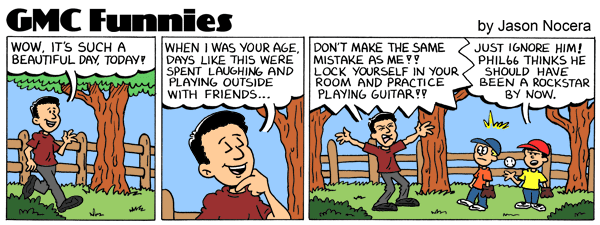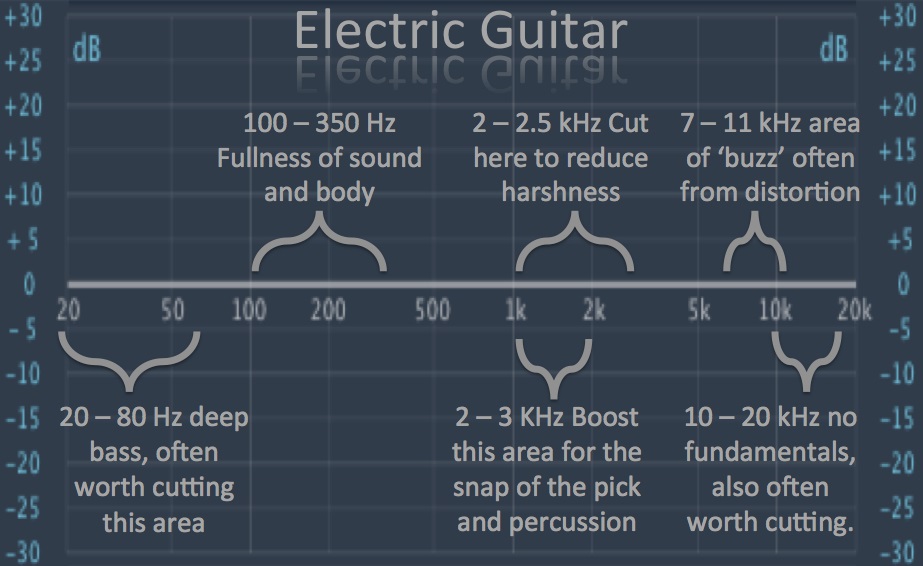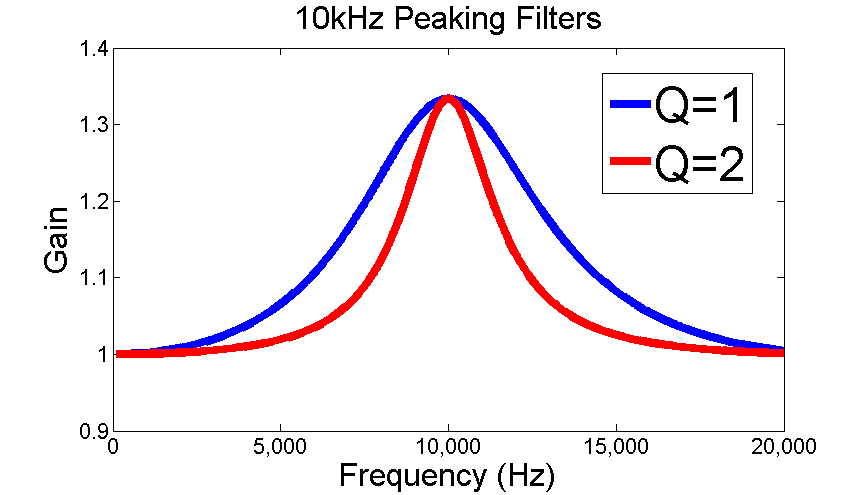Parametric Eq? |
|
|
|
|
|
| Mar 21 2017, 09:38 PM |
|
Hello,
Can you offer some explanation on the eq options here please folks, Thanks in advance  Cheers -------------------- SEE MY GMC CERTIFICATE  “Success is not obtained overnight. It comes in instalments; you get a little bit today, a little bit tomorrow until the whole package is given out. The day you procrastinate, you lose that day's success.” Israelmore Ayivor |
|
|
||
|
|
|
|
| Mar 21 2017, 11:19 PM |
|
EQ is a great thing to learn/add to one's guitar 'pedal' or understanding. As with most things, it takes fiddling with to get the hang of. Here are some snippets first about guitar EQ in general from other places.
Electric GUITAR In general, I find a light hand with broad strokes to be most effective on electric guitar, if any EQ is applied at all other than some filtering. If you do decide to go hunting, however: 80 to 90 Hz and below - Mud: Lose it, crush it with your HP filter. There's pretty much nothing useful down here, and it will almost always just equate to flabbiness and noise in your tone 150 to 200 Hz - Thickness: This is where the "guts" of a guitar normally come from, but again, can quickly cloud a mix on you. Use sparingly, perhaps automate to add sweetness to a solo section or an exposed part, and then tuck it away when things thicken up again 300 to 1,000 Hz - Life: I call this the "life" of the electric, as many of the things that make an electric sound like an electric live in this range. So attenuating needs to be taken into consideration carefully. Too much though, and you start fighting with your snare and things like that, so take note 1,000 to 2,000 Hz - Honk: This is where honky and harsh characteristics can usually be smoothed out with a wide cut centered somewhere in this range 3,000 to 8,000 Hz - Brilliance and Presence: This is the range that can add shimmer or allow a guitar to cut through a mix when boosted. It can also be where you make cuts to keep a guitar from conflicting with a vocal. If making boosts in this range, keep an eye (ear?) out for noise, as any noise present from distortion/effects pedals will very quickly be accentuated as well  Those are some basic ideas. Many great guitarists sculpted their tone using EQ before the amp, in the effects loop, and after. Those ideas above are general sound and sound mixing ideas. The power of EQ is to shape your own sound. Scooped mids, singing treble, mid boost crunch etc. You have 3 parametric eq's in your program that let you select the frequency and the q. The frequency obviously sets your target frequency, the level lets you set essentially a boost or dampening, the the q lets you essentially select the shape of the curve. Precise spike (or sort of), wider more bell shape and more frequencies effected. Essentially the q determines how frequencies close the the set frequency are effected by the boost or dampening. See pic below for an idea.  Your program also allow you to select where in the chain it appears since it has a setting labelled Post. Post amp,pre amp, post cab, pre cab etc. You also have a graphic eq. What I'd suggest is use the graphic eq to tone shape your sound and then use the PEQ as a fine tuning in various spots even post amp. Take the graphic eq mess around with it and see how it changes the sound. Try a standard boost treble or scooped mids or mid boosted. Put the GEQ before or after a distortion box, before or if able after the amp section. If your program allows, make a setting and then just move the GEQ around and see how it changes the sound based on where it is in the chain. EQ can be a powerful tool. It is frequently underutilized. I imagine a few will post there eq ideas about tone and settings. There are some good snippets about effects here from an older site. http://www.amptone.com/#eqconcepts This post has been edited by GeneT95: Mar 21 2017, 11:21 PM |
|
|
||
|
|
|
|
| Mar 21 2017, 11:39 PM |
|
This is a great reply GENET95! I think this should go in the wiki. It's that good.
Just in case some of it didn't make sense on first pass HP Filter (High Pass Filter) This lets high frequencies, e.g. treble, "pass" through and cuts off low frequencies e.g bass. There is a bunch of mud in the lower bands that typically just makes tone less usable imho. Trimmingi the lows as he mentioned will "tighten" up . your sound. Especially with high gain, the low end will "bunch up" and you get boomy/doomy/dark tone that reduces clarity. If you are making doom metal, or sabbath covers it's fine. But if you are playing something other than power chords, it just gets in the way imho. LP FILTER (Low Pass Filter) reverse of the above. Let's the Low frequencies "pass" and trims the highs. Star small with eq and play around with each setting of a given eq so that you get familiar with what each does and how it impacts the tone. Many players eq after the gain stage. This is missing out of wads of things you can do by adding eq before the gain stage. I always use a parametric eq to trim low end off before the gain to prevent mud for example. EQ is a great thing to learn/add to one's guitar 'pedal' or understanding. As with most things, it takes fiddling with to get the hang of. Here are some snippets first about guitar EQ in general from other places. Electric GUITAR In general, I find a light hand with broad strokes to be most effective on electric guitar, if any EQ is applied at all other than some filtering. If you do decide to go hunting, however: 80 to 90 Hz and below - Mud: Lose it, crush it with your HP filter. There's pretty much nothing useful down here, and it will almost always just equate to flabbiness and noise in your tone 150 to 200 Hz - Thickness: This is where the "guts" of a guitar normally come from, but again, can quickly cloud a mix on you. Use sparingly, perhaps automate to add sweetness to a solo section or an exposed part, and then tuck it away when things thicken up again 300 to 1,000 Hz - Life: I call this the "life" of the electric, as many of the things that make an electric sound like an electric live in this range. So attenuating needs to be taken into consideration carefully. Too much though, and you start fighting with your snare and things like that, so take note 1,000 to 2,000 Hz - Honk: This is where honky and harsh characteristics can usually be smoothed out with a wide cut centered somewhere in this range 3,000 to 8,000 Hz - Brilliance and Presence: This is the range that can add shimmer or allow a guitar to cut through a mix when boosted. It can also be where you make cuts to keep a guitar from conflicting with a vocal. If making boosts in this range, keep an eye (ear?) out for noise, as any noise present from distortion/effects pedals will very quickly be accentuated as well  Those are some basic ideas. Many great guitarists sculpted their tone using EQ before the amp, in the effects loop, and after. Those ideas above are general sound and sound mixing ideas. The power of EQ is to shape your own sound. Scooped mids, singing treble, mid boost crunch etc. You have 3 parametric eq's in your program that let you select the frequency and the q. The frequency obviously sets your target frequency, the level lets you set essentially a boost or dampening, the the q lets you essentially select the shape of the curve. Precise spike (or sort of), wider more bell shape and more frequencies effected. Essentially the q determines how frequencies close the the set frequency are effected by the boost or dampening. See pic below for an idea.  Your program also allow you to select where in the chain it appears since it has a setting labelled Post. Post amp,pre amp, post cab, pre cab etc. You also have a graphic eq. What I'd suggest is use the graphic eq to tone shape your sound and then use the PEQ as a fine tuning in various spots even post amp. Take the graphic eq mess around with it and see how it changes the sound. Try a standard boost treble or scooped mids or mid boosted. Put the GEQ before or after a distortion box, before or if able after the amp section. If your program allows, make a setting and then just move the GEQ around and see how it changes the sound based on where it is in the chain. EQ can be a powerful tool. It is frequently underutilized. I imagine a few will post there eq ideas about tone and settings. There are some good snippets about effects here from an older site. http://www.amptone.com/#eqconcepts |
|
|
||
|
|
|
|
| Mar 22 2017, 12:57 PM |
|
That's great, thanks, plenty to digest there.
What about the "gain only", "bandpass", "notch" and "peaking"? Cheers folks -------------------- SEE MY GMC CERTIFICATE  “Success is not obtained overnight. It comes in instalments; you get a little bit today, a little bit tomorrow until the whole package is given out. The day you procrastinate, you lose that day's success.” Israelmore Ayivor |
|
|
||
|
|
|
|
| Mar 22 2017, 09:48 PM |
|
Thanks folks,
Much learning to be done. I'm surprised at some of the sounds this thing can get. It's all about forgetting stomp boxes and learning how things work. Some have surprised me, obviously due to my lack of knowledge of how effects pedals work but things like the vibrato effect just created with digital echo! I have a lot of learning to do but slowly slowly catchy monkey A lot of the confusion is down to terminology. Like "high pass filter", why isn't it call "bass"? "Low pass filter" why isn't it called "Treble"? https://soundcloud.com/gmcphil-1/vibrato Thanks for everything folks. This post has been edited by Phil66: Mar 22 2017, 09:58 PM -------------------- SEE MY GMC CERTIFICATE  “Success is not obtained overnight. It comes in instalments; you get a little bit today, a little bit tomorrow until the whole package is given out. The day you procrastinate, you lose that day's success.” Israelmore Ayivor |
|
|
||
|
|
|
|
| Mar 22 2017, 11:08 PM |
|
There is a reverb in there but if i switch that off, the vibrato is still there. I'll record it tomorrow. I'm finding this all very fascinating and at the same time, very liberating, freeing me from stomp box mentality, not that there is anything wrong with that but, i feel i will have a deeper understanding of effects in a year or so.
I don't understand this, "Use sparingly, perhaps automate to add sweetness to a solo section". What's a "wide cut", "1,000 to 2,000 Hz - Honk: This is where honky and harsh characteristics can usually be smoothed out with a wide cut centered somewhere in this range" I still think if Boss could get amp sims as good as the Amplifire and Cab IRs with stomp box simplicity i might still be tempted. Peace This post has been edited by Phil66: Mar 23 2017, 08:02 AM -------------------- SEE MY GMC CERTIFICATE  “Success is not obtained overnight. It comes in instalments; you get a little bit today, a little bit tomorrow until the whole package is given out. The day you procrastinate, you lose that day's success.” Israelmore Ayivor |
|
|
||
|
|
|
|
| Mar 23 2017, 09:25 PM |
|
So, here is the vibrato effect just using the delay block, no reverb.
https://soundcloud.com/gmcphil-1/vibrato-no-reverb Here are the settings. I wish the interface could expand to show more but when you enlarge it it just makes everything bigger, you see no more    -------------------- SEE MY GMC CERTIFICATE  “Success is not obtained overnight. It comes in instalments; you get a little bit today, a little bit tomorrow until the whole package is given out. The day you procrastinate, you lose that day's success.” Israelmore Ayivor |
|
|
||
|
|
|
|
| Mar 23 2017, 10:34 PM |
|
Thanks buddy, I'll take it easy.
I didn't really have a question about the vibrato I think I am going to learn lots about stomp boxes and how many stomp boxes are really just tweaked and amalgamated versions of other effects, am I correct thinking this? Cheers buddy -------------------- SEE MY GMC CERTIFICATE  “Success is not obtained overnight. It comes in instalments; you get a little bit today, a little bit tomorrow until the whole package is given out. The day you procrastinate, you lose that day's success.” Israelmore Ayivor |
|
|
||
|
|
|
|
| May 5 2017, 12:28 PM |
|
I tried to put together all the info in this thread in this wiki entry:
https://www.guitarmasterclass.net/wiki/inde...p/Parametric_EQ Feel free to add/change/correct whatever you guys see fit, or let me know about it -------------------- Guitars:
Fender American Deluxe Stratocaster, Ibanez RG2570MZ, Epiphone SG G-400 Amp: Vox AC4TVH head + V112TV cab Effects: Vox Satchurator, Vox Time Machine, Dunlop CryBaby, Boss MT-2, Boss CE-5, Boss TU-2, Boss ME-70 Recording: Line-6 POD X3 + FBV-Express, Pandora PX5D GMC wants YOU to take part in our Guitar-Wikipedia! Have a good time reading great articles and writing your own with us in our GUITAR WIKI! Share your playing and get Pro-advice from our Instructors: Join REC |
|
|
||
1 User(s) are reading this topic (1 Guests and 0 Anonymous Users)
0 Members:





























